7 Infamous Examples Healthcare Fraud in Florida
Due to its size, Florida has a massive healthcare industry. Unfortunately, that also means healthcare fraud exists within that state. Here are 7 real-world and infamous examples of healthcare fraud in Florida.
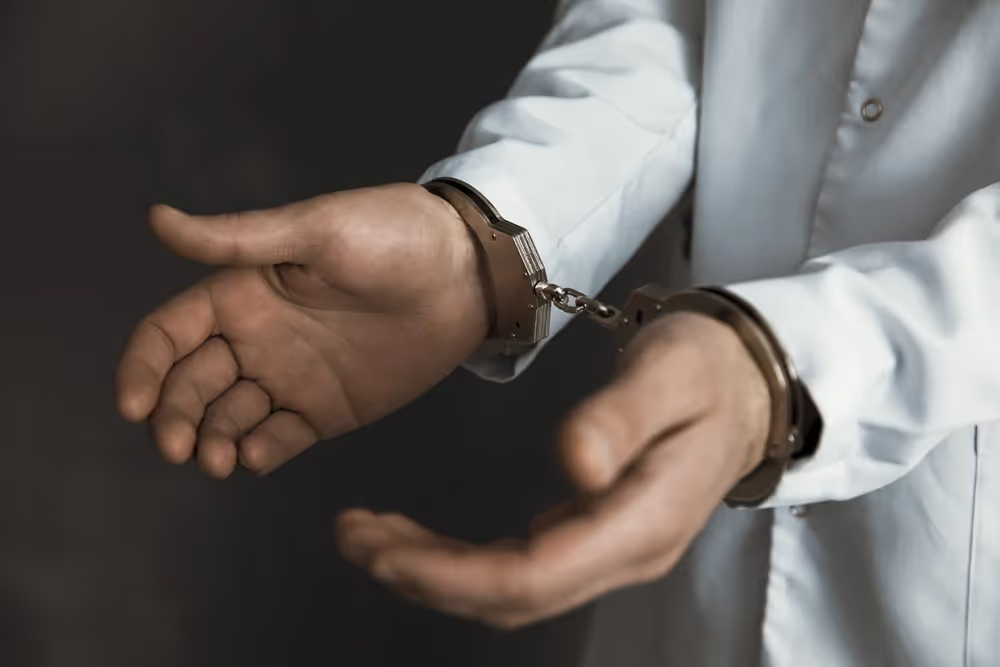
Healthcare fraud is not a victimless crime. The Department of Justice (DOJ) estimates that healthcare fraud generates roughly $100 billion a year.
Unfortunately, that means this type of crime happens all the time. What’s worse is that these schemes are hard to detect and understand.
Oftentimes, perpetrators will commit one type of healthcare fraud to cover up other parts of the greater scheme. As you’ll learn from reading this blog, fraud by medical professionals can mimic legitimate transactions from insurers to providers.
This type of crime has serious costs associated with it too. It’s expensive because of the money the fraudster steals. Of course, there are also the costs associated with jail time and monetary penalties fraudsters face when caught.
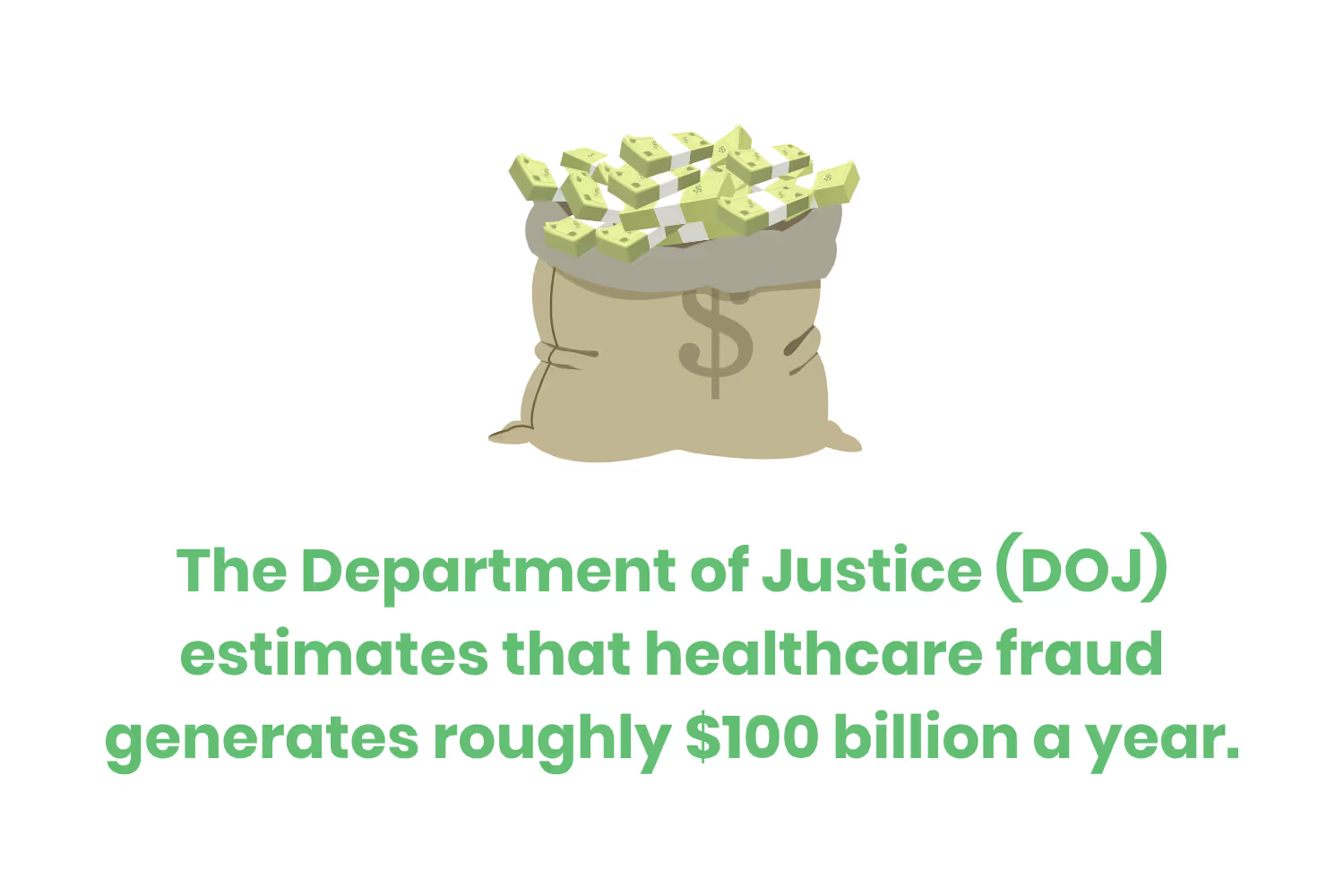
With so many cases that occur, it might seem like there’s no end in sight. But, there is a pattern.
Some states tend to have more cases of healthcare fraud than others. And there appears to be a correlation between the monetary value of healthcare in a state and the amount of fraud that occurs.
Florida is one such state where that correlation seems to exist. To put the scale of Florida’s healthcare into perspective, the state’s home healthcare industry clocks in at $6.2 billion.
But, what does healthcare fraud look like in this state?
Below are 7 examples of healthcare fraud in Florida to help illustrate how it happens, how different forms of fraud present themselves in real life, and the severity of the consequences.
What is healthcare fraud?
Healthcare fraud affects everyone, including individuals and businesses. This illegal activity causes billions of dollars in losses every year.
Common types of healthcare fraud committed by medical providers include…
- Double billing - Submitting more than one claim for the same service
- Phantom billing - Submitting a claim for something that never happened
- Unbundling - Submitting multiple bills for the same service
- Upcoding - Billing for a service that is more expensive than what was actually provided
- Billing for Unnecessary Services - Submitting claims for services that the patient didn’t need.
- Kickbacks - An agreement to provide something of value in return for patients coming to the practice.
- Forgery - Forging prescriptions
- Diversion - Using legal prescriptions for illegal purposes
- This includes selling the pills on the side
The FBI is the primary agency for investigating healthcare fraud. They investigate, arrest, and convict individuals for both federal and private insurance fraud schemes.
Healthcare Fraud in Florida
January 2023 - Michael Ligotti
Michael Ligotti was a medical director for over 50 addiction treatment facilities, also known as “sober homes'', in Palm Beach County. He practiced as a doctor of osteopathic medicine.
Ligotti ended up pleading guilty to committing healthcare fraud in October 2022. As a result, the courts ordered him to suspend his medical license.
So what did he do and what was the healthcare fraud scheme?
Ligotti owned a company called Whole Health LLC. This company provided treatment and testing to substance abuse patients. As I mentioned before, Ligotti was a medical director of many sober homes.
Because of the potential conflict of interest, Ligotti allegedly conspired using a quid pro quo scheme. As the director, the doctor gave “standing orders,” which authorized staff in sober homes to perform testing. The staff would then bill insurers for tests.
In return, Ligotti received access to a steady supply of patients from the homes of his LLC. The clinic would then conduct unnecessary and expensive testing on referred patients and bill their insurance for tests. Some of these tests cost more than $26,000!
In total, this Florida doctor charged healthcare benefit programs and insurance companies approximately $764 million from 2011 to 2020. He took $127 million for himself.
A Florida Judge sentenced him to 20 years in prison as punishment.
In this healthcare fraud example, the doctor was billing for unnecessary services to fraudulently inflate insurance payments.
This form of billing is a subcategory of unbundling since the doctor is submitting more expensive services that aren’t needed. Inaccurate claims for procedures that took place can increase reimbursement.
This example of a scheme also includes the kickback form of healthcare fraud. The doctor agreed to do something of value for the sober homes in exchange for patients. In other words, the doctor agreed to do something that would help the addiction treatment facilities make superficial profits in exchange for him making more money at his LLC.
December 2022 - 9 Citizens Convicted
The FBI arrested and charged nine Florida residents with healthcare fraud and conspiracy to commit healthcare fraud. The nine individuals went to prison in December 2022.
The defendants were…
- Arisleidys Fernandez Delmas,
- Her mother, Leidys Delmas Garcia
- Her husband, Pedro Hugo Prieto Garcia
- Daimara Borroto Garcia
- Elias Caises Maurino
- Yohana Iriza (a/k/a Yohana Lozada)
- Her ex-husband Gabriel Lozada
- Their son Anthony Lozada
- Julio Acosta Perez
According to the allegations in three related indictments and statements, the nine individuals conspired to submit roughly $37 million in fraudulent claims to Blue Cross Blue Shield.
The scheme started in 2018 and lasted until 2022. In this timeframe, the defendants allegedly paid kickbacks to employees at JetBlue Airways, AT&T Inc.; and TJX Companies Inc.
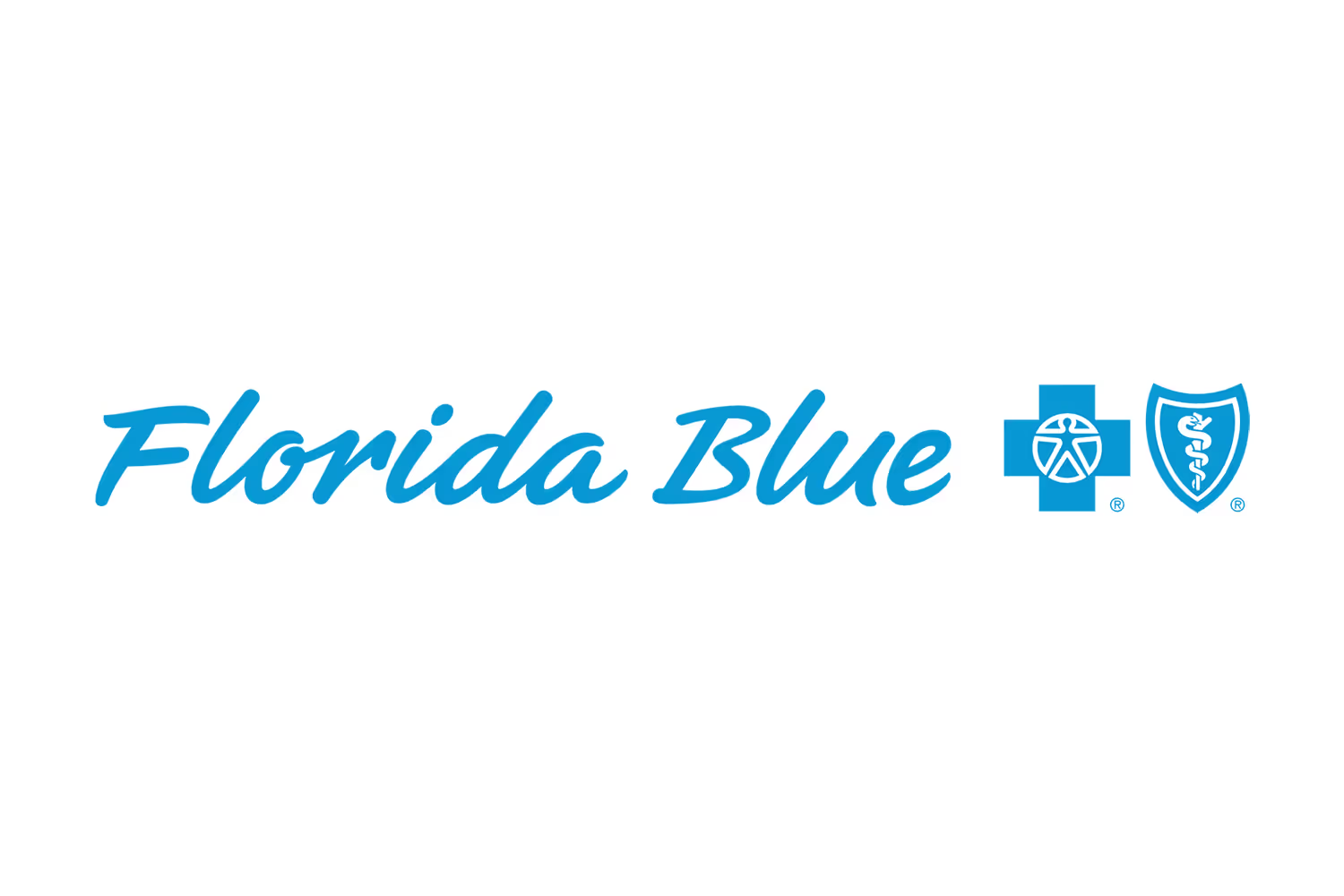
The defendants paid these people to come as patients to various South Florida Physical therapy clinics. Those who owned these clinics then submitted fraudulent claims to Blue Cross for healthcare benefits. The procedures in the claims were either not medically necessary or not provided.
The defendants also allegedly paid kickbacks to their co-defendants in return for referring additional Blue Cross beneficiaries to the clinics. In other words, a few of the defendants paid others to participate in the scheme by finding people to fake their patient status with the physical therapy clinics.
These co-defendants include a licensed massage therapist and operators of the physical therapy clinics.
As of the start of 2023, the courts have not convicted any of the nine defendants. If convicted, each of them faces 10 years in prison per count.
This example also involves upcoding, billing for unnecessary services, and kickbacks.
The defendants allegedly paid people to come to their practice so the practices could falsely bill for physical therapy treatment. This is a textbook case of what kickbacks look like in real life. It is also a classic example of unbundling as a method to falsely inflate profits.
December 2022 - Ruth Fernandez
December 2022 was a bad month for healthcare fraud in Florida because Ruth Fernandez was also convicted. You see, a judge sentenced Fernandez to three years in prison for her role in the conspiracy to commit healthcare fraud. She was also indicted for making a false statement in a situation involving a federal healthcare benefit program.
What happened that led to a woman spending three years in prison?
According to court documents, the fraud happened from January 2018 to April 2019. Fernandez worked under Patsy Truglia’s supervision and direction. Truglia received a previous sentencing of 15 years in prison.
Under Truglia’s supervision, Fernandez generated medically unnecessary physician’s orders through a telemarketing operation for certain orthotic devices. Referred to as Durable Medical Equipment (DME), these devices include knee braces, back braces, wrist braces, and other braces.
Through the telemarketing operation, Fernandez harvested personal and medical information to create unnecessary DME brace orders. These were then forwarded to purported “telemedicine” vendors.
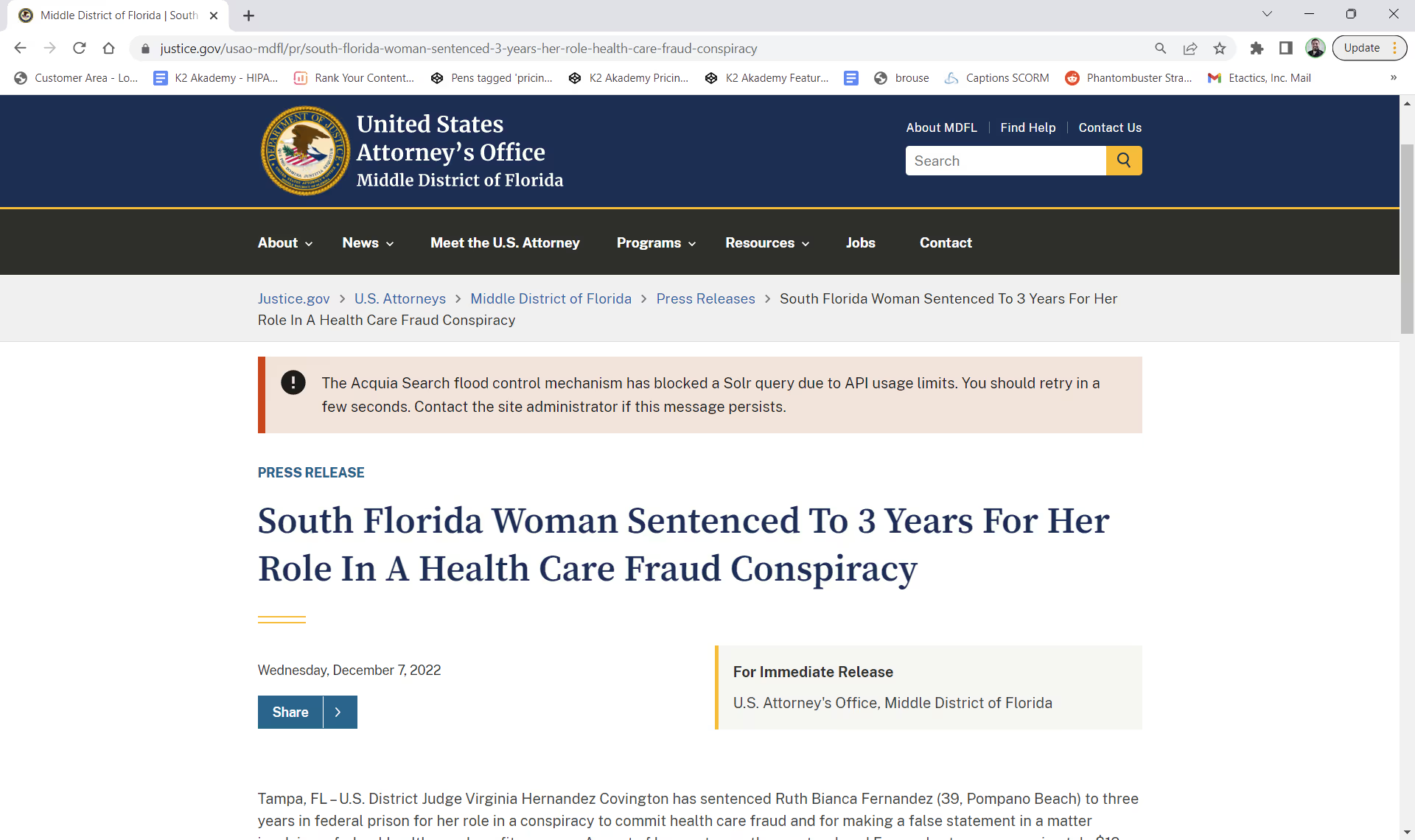
In exchange for a fee, these vendors paid illegal bribes to physicians to sign the orders. This was all done without ever contacting the beneficiaries to conduct the required telehealth consultations. The illegal brace orders were then returned to Truglia’s telemarketing operation.
To avoid Medicare scrutiny Fernandez spread the fraudulent claims across five DME storefronts operated by Truglia’s control and Fernandez’s management.
Through the five storefronts, Truglia, Fernandez, and other conspirators caused approximately $25 million in fraudulent DME claims submitted to medicare. This resulted in roughly $12 million in payments.
The judge found Fernandez guilty of fraud. As part of her sentencing, Fernandez has to pay approximately $12 million to the affected government healthcare programs and insurance companies. The courts spread this dollar amount across several co-conspirators involved in the scheme.
The court also entered an order of forfeiture in the amount of $62,650 against Fernandez.
Now that the trial’s over and Fernandez received her sentencing, we need to determine the type of healthcare fraud involved in the case.
The conspiracy used medical identity theft to fraudulently place orders for the braces. According to the Medical Identity Theft Alliance, more than 2 million Americans were victims of medical identity theft. Medical identity theft involves the misuse of someone’s information to submit claims. In this particular case, people stole information from patients to make fraudulent DME claims.
This case also includes phantom billing. The patients were never contacted by the telemarketing scheme. They were never patients where Fernandez worked. Therefore, any claims submitted were for procedures and treatments that never happened.
Billing for unnecessary services/items and upcoding are also present in this case. There’s a good chance that the people linked to the stolen information never actually needed the braces. Therefore, the claims for the braces were completely unnecessary.
February 2022 - Patsy Truglia
Remember how I was talking about Patsy Truglia in the story above? A judge sentenced him in February 2022, 11 months before the sentencing of his subordinate Ruth Fernandez. Truglia was the brains of the fraud operation while Fernandez helped carry it out.
Truglia is now serving 15 years in federal prison for his role in two consecutive conspiracies. These include conspiracies to commit healthcare fraud and for making a false statement in a matter involving a healthcare benefit program.
The court ordered Truglia to pay $8.3 million to the affected government health programs and insurance companies. The court also entered a money judgment against Truglia, totaling over $10.11 million.
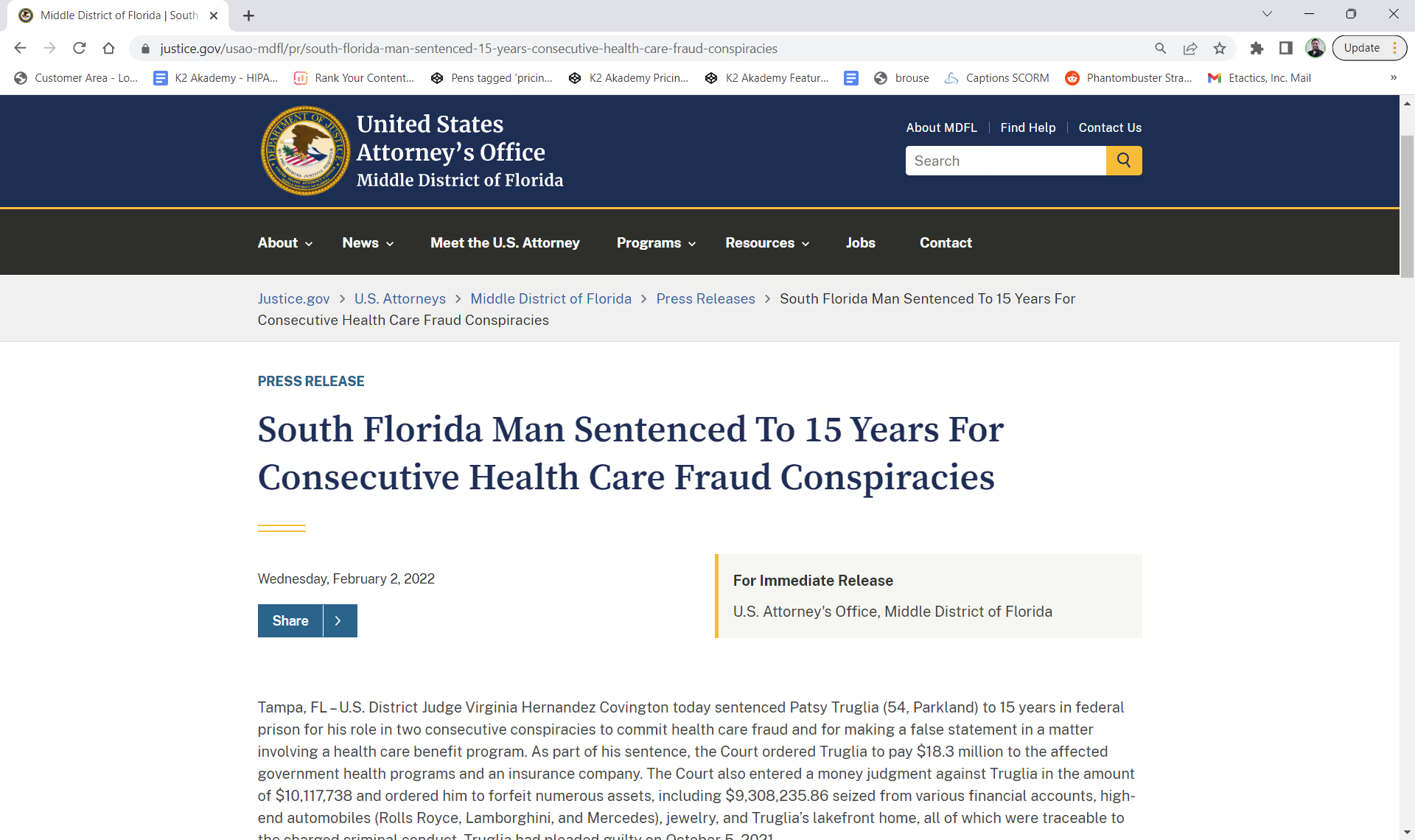
Truglia had to forfeit numerous assets including roughly $9.3 million seized from…
- Various financial accounts
- High-end automobiles
- These include Rolls Royce, Lamborghini, and Mercedes vehicles
- Jewelry
- A lakefront home
All of these assets were traceable to criminal conduct. In other words, Truglia paid for these assets with illegally obtained funds.
February 2022 - 10 Citizens Convicted
Healthcare fraud and wire fraud can often go hand-in-hand. According to Investopedia, wire fraud involves the use of some form of telecommunications or the internet. It can make use of any and all forms of electronic communication and media.
This includes…
- Telephone
- Fax machine
- Social media
- SMS
- Text messaging
When healthcare malpractice involves wire fraud, perpetrators can face both hefty fines and jail time.
This is exactly what happened to ten Florida residents. A jury convicted them for their alleged roles in wire fraud and healthcare fraud involving kickbacks and money laundering.
What did they do?
Daniel M. Carver, Thomas Dougherty, and John Paul Gosney Jr. were the owners and managers of independent clinical laboratories and marketing companies.
After their arrests, these three men were each charged with…
- Conspiracy to commit healthcare fraud
- Healthcare fraud
- Conspiracy to pay and receive healthcare kickbacks and bribes
- Paying and receiving kickbacks and bribes
- Conspiracy to commit money laundering
- Money laundering offenses
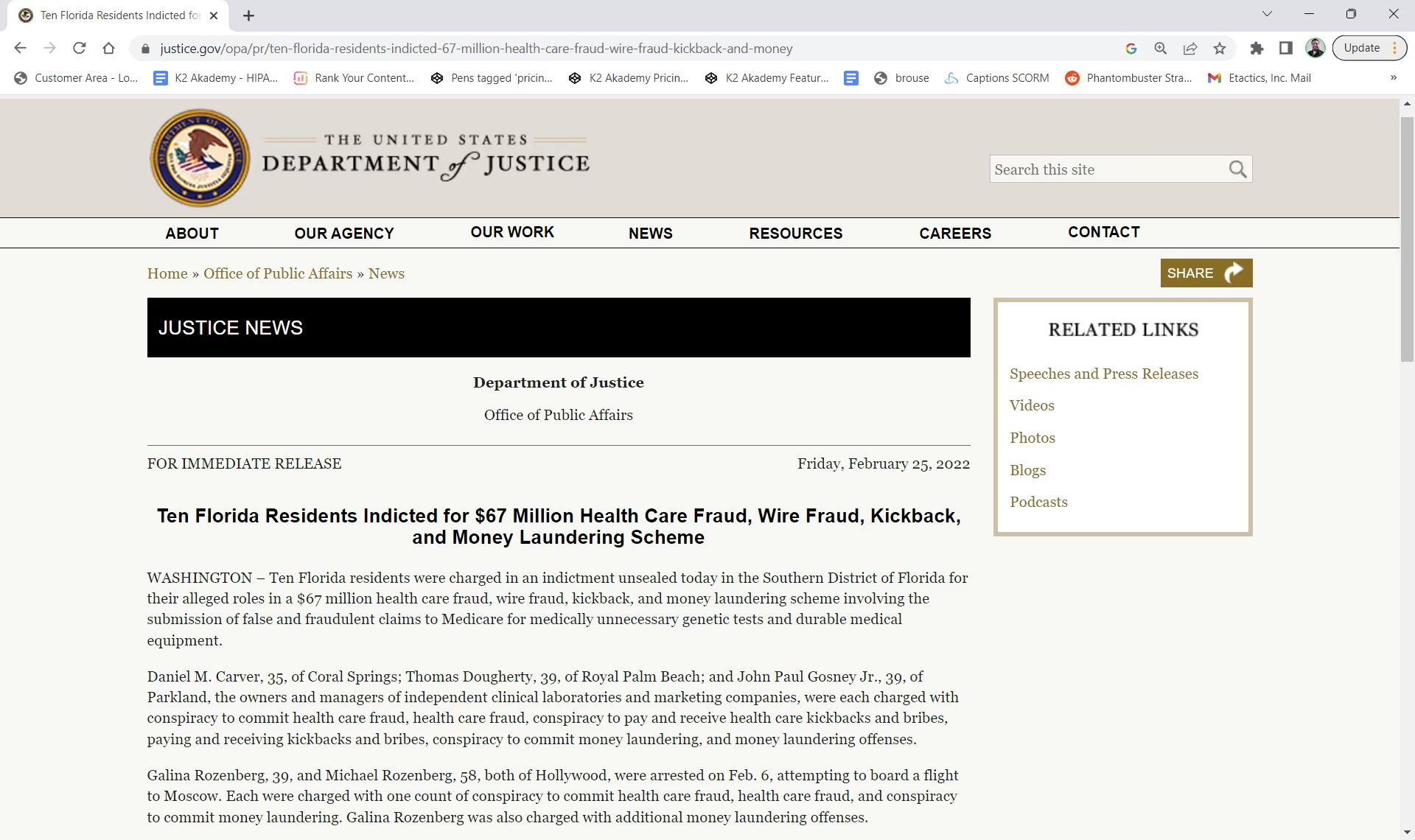
Galina Rozenberg and Michael Rozenberg were in the airport when arrested after attempting to board a flight to Moscow. In other words, they were trying to flee the country.
Each faced charges of…
- One count of conspiracy to commit healthcare fraud
- Healthcare fraud
- Conspiracy to commit money laundering
Rozenberg faced additional money laundering offenses.
Louis Carver, Timothy Richardson, Ethan Macier, and Jose Goyos were each charged with…
- Conspiracy to commit healthcare fraud
- Healthcare fraud
- Conspiracy to commit money laundering
- Money laundering offenses
Police charged Ashley Cigarroa with one count of conspiracy to commit healthcare fraud and committing healthcare fraud.
Now that we know who the ten defendants are and the charges against them, we can dive into what they did to get arrested and put in prison.
Between January 2020 and July 2021, these ten people referred Medicare beneficiaries for medically unnecessary genetic tests and durable medical equipment. This means that they committed a form of upcoding fraud.
They participated in kickback fraud by paying bribes to telemedicine companies in exchange for doctors’ orders for genetic tests and equipment.
The judgment further alleged that the defendant falsified forms related to Medicare enrollment. They did this to conceal the true owners and managers of certain laboratories. They proceeded to submit false and fraudulent claims to medicare. In essence, the ten defendants participated in medical identity theft to conceal other illegal behavior.
When it comes to sentencing and imprisonment, federal charges for conspiracy to commit healthcare fraud and wire fraud, conspiracy to commit money laundering, and money laundering are each punishable by 20 years in prison at most.
Healthcare fraud and anti-kickback violations are each punishable by a maximum of 10 years in prison. Conspiracy to pay and receive kickbacks is punishable by a maximum penalty of five years in prison.
December 2021 - 2 Citizens Convicted
Prescription fraud is much more common than we would like to admit.
Creating or using forged prescriptions is a crime that can lead to severe consequences. Physicians, hospitals, insurers, and taxpayers can all partake in this type of fraud scheme and get hurt by it.
This next story is all about this type of fraud and how two Florida pharmacists learned their lesson the hard way.
Two men from Tampa, Florida, and six others face allegations of deceiving pharmacy benefit managers into approving thousands of fraudulently-obtained prescriptions. The judge sentenced Peter Bolos to 14 years in prison and Michael Palso to 33 months. Both had to pay more than $24.6 million each in restitution.
What exactly did they do to land themselves in prison?
Bolos and Palso deceived pharmacy benefit managers into approving prescriptions that were fraudulently obtained. Private insurers then paid pharmacies owned by the two men for the prescriptions.
Between May 2015 and April 2018, Bolos, Palso, and six others submitted $931 million in fraudulent claims. They received a total of $174 million in paid billings. Bolos were responsible for $89 million of that total.
You see, Bolos, Palso, and another defendant owned a pharmacy. They hired another defendant to use his telemarketing company, HealthRight, to sell prescription meditations through cold calling. In the telemarketing portion of the scheme, customers would provide their insurance to pay for the drugs.
The drugs chosen for the scheme included pain creams, scar creams, and vitamins. Court records show that Bolos chose drugs that could create profitable reimbursements at inflated prices.
Because of the scale of the fraud scheme, the judge believes that 14 years in prison reflects the seriousness of the crime.
As you can see, prescription fraud is very serious. It doesn't always involve opioids and painkillers that are resold on the black market. In this example of fraud, the prescriptions were non-addictive, controlled substances.
This scheme also illustrates phantom billing along with medical identity theft. The patients never received their prescriptions. If they did get them, they had to pay outrageously high prices. In turn, this inflated the pharmacy’s bottom line. The doctors writing the prescriptions never met the patients. The services on the claims never happened.
April 2019 - Philip Esformes
Philip Esformes was a healthcare facility owner in Miami, Florida before his 20-year prison sentence in 2019. The judge also sentenced him to 3 years of supervised release.
After a jury trial that lasted 8 weeks, they found Esformes to be guilty of…
- 1 count of conspiracy to defraud the United States
- 2 counts of receipt of kickbacks in connection with a federal healthcare program
- 4 counts of payment of kickbacks in connection with a federal healthcare program
- 1 count of conspiracy to commit money laundering
- 9 counts of money laundering
- 2 counts of conspiracy to commit federal program bribery
- 1 count of obstruction of justice
The evidence presented during the trial revealed that Esformes led an extensive healthcare fraud conspiracy between January 1996 and July 2016. The scheme involved a network of assisted living facilities and skilled nursing facilities that he owned.
Esformes bribed physicians to admit patients into his facilities. This means he readily participated in kickback medical fraud.
Once he obtained patients, he cycled them through his facilities where they often failed to receive appropriate medical services. They also received medically unnecessary services billed to Medicare and Medicaid. This means that Esformes participated in multiple forms of upcoding.
Esformes concealed the unsanitary and poor conditions of his facilities and his illegal schemes from authorities by bribing a state regulator. He asked the regulator for advance notice of surprise inspections of his facilities so he could cover up and make the buildings look better than they were.
The evidence went on to show that Esformes personally benefited from the fraud and received more than $37 million. The scheme’s total value was upwards of $1.3 billion.
Conclusion
Let’s go over some of the most common forms of healthcare fraud one more time.
Medical identity theft lets perpetrators use existing patient information, like someone's name, birth date, or medicare card, to generate revenue.
Billing for unnecessary or expensive services allows practices to inflate profits. For example, ordering braces for a patient that doesn’t need them is a form of fraud. So is billing for expensive prescription drugs that have high-profit margins.
Kickbacks are a form of healthcare fraud characterized by a quid pro quo relationship or bribery. Offering payments to practices as an incentive to send patients over can lead to corruption in medical decision-making and more.
There are a few ways to make sure you do not fall victim to healthcare fraud. When receiving your claim, make sure to take note of any billing items or services that have not been properly documented. Also, be sure to check your records to see if there is an existing bill for that patient’s treatment.
Healthcare fraud has serious costs and consequences, regardless of the state you’re in. But, as you can see, Florida has seen its share of infamous schemes.
Emphasize your product's unique features or benefits to differentiate it from competitors
In nec dictum adipiscing pharetra enim etiam scelerisque dolor purus ipsum egestas cursus vulputate arcu egestas ut eu sed mollis consectetur mattis pharetra curabitur et maecenas in mattis fames consectetur ipsum quis risus mauris aliquam ornare nisl purus at ipsum nulla accumsan consectetur vestibulum suspendisse aliquam condimentum scelerisque lacinia pellentesque vestibulum condimentum turpis ligula pharetra dictum sapien facilisis sapien at sagittis et cursus congue.
- Pharetra curabitur et maecenas in mattis fames consectetur ipsum quis risus.
- Justo urna nisi auctor consequat consectetur dolor lectus blandit.
- Eget egestas volutpat lacinia vestibulum vitae mattis hendrerit.
- Ornare elit odio tellus orci bibendum dictum id sem congue enim amet diam.
Incorporate statistics or specific numbers to highlight the effectiveness or popularity of your offering
Convallis pellentesque ullamcorper sapien sed tristique fermentum proin amet quam tincidunt feugiat vitae neque quisque odio ut pellentesque ac mauris eget lectus. Pretium arcu turpis lacus sapien sit at eu sapien duis magna nunc nibh nam non ut nibh ultrices ultrices elementum egestas enim nisl sed cursus pellentesque sit dignissim enim euismod sit et convallis sed pelis viverra quam at nisl sit pharetra enim nisl nec vestibulum posuere in volutpat sed blandit neque risus.

Use time-sensitive language to encourage immediate action, such as "Limited Time Offer
Feugiat vitae neque quisque odio ut pellentesque ac mauris eget lectus. Pretium arcu turpis lacus sapien sit at eu sapien duis magna nunc nibh nam non ut nibh ultrices ultrices elementum egestas enim nisl sed cursus pellentesque sit dignissim enim euismod sit et convallis sed pelis viverra quam at nisl sit pharetra enim nisl nec vestibulum posuere in volutpat sed blandit neque risus.
- Pharetra curabitur et maecenas in mattis fames consectetur ipsum quis risus.
- Justo urna nisi auctor consequat consectetur dolor lectus blandit.
- Eget egestas volutpat lacinia vestibulum vitae mattis hendrerit.
- Ornare elit odio tellus orci bibendum dictum id sem congue enim amet diam.
Address customer pain points directly by showing how your product solves their problems
Feugiat vitae neque quisque odio ut pellentesque ac mauris eget lectus. Pretium arcu turpis lacus sapien sit at eu sapien duis magna nunc nibh nam non ut nibh ultrices ultrices elementum egestas enim nisl sed cursus pellentesque sit dignissim enim euismod sit et convallis sed pelis viverra quam at nisl sit pharetra enim nisl nec vestibulum posuere in volutpat sed blandit neque risus.
Vel etiam vel amet aenean eget in habitasse nunc duis tellus sem turpis risus aliquam ac volutpat tellus eu faucibus ullamcorper.
Tailor titles to your ideal customer segment using phrases like "Designed for Busy Professionals
Sed pretium id nibh id sit felis vitae volutpat volutpat adipiscing at sodales neque lectus mi phasellus commodo at elit suspendisse ornare faucibus lectus purus viverra in nec aliquet commodo et sed sed nisi tempor mi pellentesque arcu viverra pretium duis enim vulputate dignissim etiam ultrices vitae neque urna proin nibh diam turpis augue lacus.




